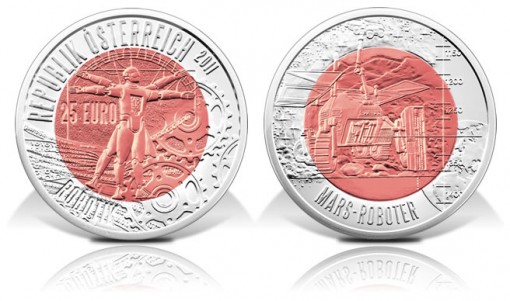The Austrian Mint has issued the 2011 edition of its highly sought after niobium and silver bimetallic coin, this year featuring Robotics.

Robotics is no longer science fiction but an integral part of our daily lives. Almost every aspect of our modern lives has been touched by Robotics from simple tasks such as vacuuming, or pool cleaning to precision manufacturing or voice controls in cars, protecting soldiers in the field and exploration of outer space, to name but a few.
2011 Robotics Bimetallic Silver and Niobium Coin Designs
The obverse of the new bimetallic coin features a robot in a humanoid form, reflecting the Vetruvian man of Leonardo Da Vinci, recognizing the advanced thinking of this great man, and reminding us all that we are a product of centuries of thinking. The perfectly proportioned Vetruvian man is easy to replicate in the man-made world of Robotics.
The "robot’s" arms in the two positions are exactly proportioned to fit right to the edge of the niobium core. The Vetruvian-like robot is standing on lines of zeros that run from the outer silver ring across the niobium core and onto the other side of the silver ring, representing the thousands of lines of binary code that are required to program a robot. To the right side of the robot are three cogwheels emblematic of the inner mechanics of a robot. The binary code and the cogwheels, represent the electronic and mechanical worlds that are required for developments in robotics.
Also on the obverse of the coin and located in the silver ring is the country of issue "Republik Oesterreich," Republic of Austria and the year of issue 2011. The face value of the coin, 25 euros, is located in the left quadrant of the pure niobium design field. Mint engraver Helmut Andexlinger designed this side of the coin.
The reverse of the coin was designed by the Mint’s chief engraver Thomas Pesendorfer and depicts a robotic lander on the surface of Mars — hence the deep reddish-pink color of the 2011 niobium coin. The Mars lander is based on a design of the European Space Agency. The six-wheeled lander operates on solar power collected by the lander, and noted in the large solar panels coming up from the lander in the middle third of the coin design. The lander is also equipped with a camera seen in the middle of the silver ring at the top of the coin. In the background is a mountainous Martian landscape covered with boulders. At the top and the left of the silver ring stars are depicted. Earth is noted in the lower part of the silver ring.
The niobium core of the 2011 edition has been oxidized prior to the striking. When the niobium core and the silver ring are placed into a coin press and then struck twice the metals fuse together and the oxidized surface of the reddish pink core takes on a shimmer that creates a rainbow effect on the surface of the coin’s core. One can see a shimmer of bronze, blue, purple, pink and copper on the niobium surface of the core. The flow of the metal during the striking process determines how the shimmer effect will finally appear and therefore each coin has a unique color.
The word robot has been around since 1921 when Czech playwright Karl Capek coined the word "robot" in his play "Rossum’s Universal Robots, R.U.R.". The word comes from the Czech word robota meaning forced labor, and repetitive work. Robots early on were found in manufacturing facilities completing simple repetitive work.
Now robots are used for much more complex and intricate work completing several tasks in one smooth and efficient motion. The sophistication of robots is ever increasing, such that today cognitive computing is used more and more to program them. The fields of psychology, neuroscience, computer science, mathematics are all coming together with the science of electronics and mechanics. Robots have "learned" to "play" sports such as soccer and ping-pong, and are very dexterous at conducting complex operations on humans in hospitals. We can hardly imagine how robots will continue to evolve and how robots will bring the world to us in the future.
2011 Austrian Robotics Bimetallic Coin Specifications
The new 25-euro coin is issued with a maximum mintage of 65,000 pieces and is struck in special uncirculated quality only. It has a diameter of 34 mm and contains 9 grams of 900 fine silver in the outer ring. The core consists of 7.15 grams of 998 pure niobium. Each coin is encapsulated, boxed and accompanied by a numbered certificate of authenticity.
| Center | 6.5 g pure niobium |
| Ring: | 9 g silver (900 fine) |
| Finish: | Special Uncirculated |
| Diameter: | 34 mm |
| Mintage: | 65,000 |
| Date of Issue: | 16 March 2011 |
| Face Value: | 25 euro |
| Designer: | Helmut Andexlinger / Thomas Pesendorfer |
Collectors in the United States and Canada may purchase the "Robotics" coin issue for 74.00 USD each by calling Euro Collections International toll free at 1 877 897 7696. The coin may also be ordered online at www.eurocollections.com.
About the Austrian Mint
The Austrian Mint (http://austrian-mint.at/) is situated in the heart of Vienna and is the official minting authority for Austria with a 800 year history.
The Mint is the source for all Austrian Euro and Cent coins, whether they are intended for shopping, as an investment or for collection. Before the Euro, the Schilling and Groschen coins were minted, and before that — during the monarchy — Crowns, Guilders and Ducats were struck by the Austrian Mint.
The company is located close to the center at the Vienna Stadtpark in a Biedermeier building erected under Emperor Ferdinand I. from 1835 to 1837. Today it accommodates one of the most modern mints in the world.





